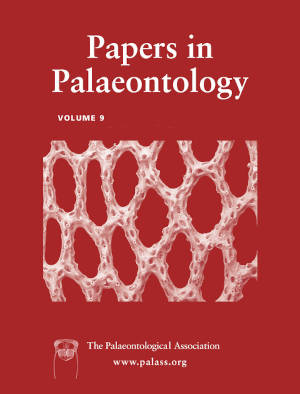Article: The dental system of †Kazanichthys viatkensis (Actinopterygii, Acrolepididae) from the middle Permian of European Russia: palaeobiological and palaeoecological inferences
Publication: Papers in Palaeontology
Volume:
9
Part:
4
Publication Date:
2023
Article number:
e1512
Author(s):
Aleksandr S. Bakaev, Zerina Johanson, and Aaron LeBlanc
DOI:
10.1002/spp2.1512
Abstract
Abstract Among ray-finned fishes (Actinopterygii), the crushing, durophagous feeding strategy first evolved in the early Carboniferous period, with the †Eurynotiformes possessing dentitions with single layers of partially to fully fused blunt teeth. In the †‘Platysomidae’ (Permian), a new form of crushing dentition evolved (phyllodonty), in which multiple layers of superimposed crushing teeth developed intraosseously, within the jaw. The phyllodont durophagous dentition is also recovered from later-occurring taxa originating mainly in the Mesozoic, such as the †Bobastraniiformes, the neopterygians †Pycnodontiformes and Ginglymodi, and in the teleost group †Phyllodonta. By comparison, †Kazanichthys viatkensis, an actinopterygian from the middle Permian of European Russia, is characterized by a third, putatively durophagous dentition, with anterior conical teeth and closely packed molariform teeth on the buccal dental plates (a potential similarity with eurynotiforms). Whereas the conical teeth are similar to those of basal actinopterygians, the molariform teeth superficially resemble teeth of some teleosts (Characiformes, Tetraodontiformes), but are unique among known fossil and living Actinopterygii in being crowned by anastomosing, sharp apical ridges. Teeth are ankylosed to the jaw and acrodont in implantation. There is neither evidence of plicidentine, nor cavities corresponding to intraosseous crypts. Most replacement teeth formed extraosseously, differing from the phyllodont dentition, but similar to several more phylogenetically basal actinopterygians. The dental system morphologically resembles recent Sparidae (Teleostei; Perciformes), possibly indicating a similar trophic adaptation. Based on these comparisons and patterns of wear, we propose that †K. viatkensis was a generalist durophagous feeder, with the ability to switch prey types with its unique and complex dentition.
